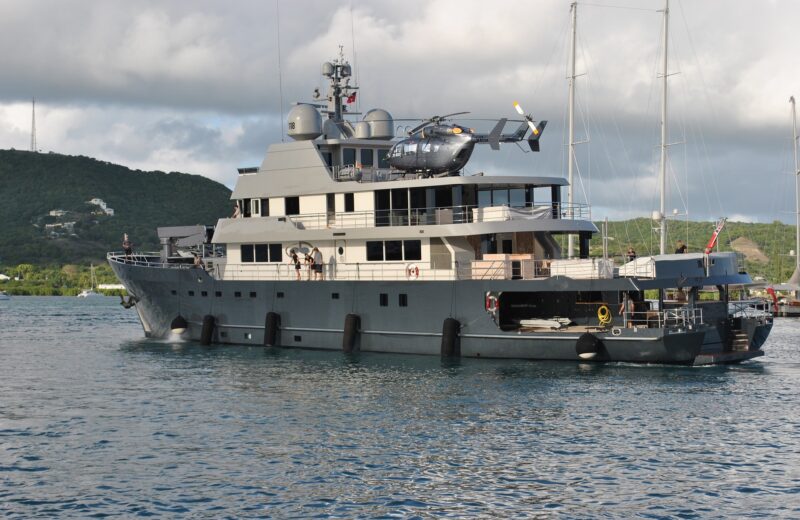Nigel Watson Q&A: Helidecks on Yachts

You have had a long week and you are back home for the weekend. Your family are currently cruising around the Ionian Islands and you want to get there as soon as possible to have a nice, long, relaxing weekend in the sun.
The trouble is, your family are currently floating miles off the coast, and it would take hours for the boat to head back into port and pick you up or for you to sail over. And you want to invite a few of your friends out for lunch on the yacht. How will they get there?
This is where a helideck comes in. More and more yacht owners are looking to make their vessels “helideck operational” but it needs a lot of consideration.
Helicopters and yachts are two different kettles of fish, and there are only a few people who have the crossover knowledge to tell you what you need to do.
We sat down with aviation and yachting consultant and CEO of aviation management firm Luviair Nigel Watson, and asked him what people who want to have a helicopter on their yacht should consider first.
Superyacht Investor: What should yards tell owners who want a helideck on their yacht?
Nigel Watson: That it is possible. The yard should understand what the owner’s expectations are and then advise him or her honestly whether it is possible within the preliminary designs of the new build or achievable in the proposed refit process. The owner does not want to ask a helicopter company or his own pilot to fly to his yacht and then be told the deck is not fit for purpose.
Superyacht Investor: How do you get a yacht helideck operational?
Nigel Watson: Firstly, that yacht needs to pass a commercial deck inspection and be available for commercial use. The specific inspecting process will be decided on where the vessel is registered. For example, the Red Ensign Group of yacht registries [UK, Isle of Man, Bermuda] will be following the Maritime and Coastguard Agency certification standards.
You need to consider what real estate could be allocated on board the vessel to the landing area. Low cost real estate areas such as the forepeak are poor landing areas. High value real estate areas around midships aft of the mast are higher value and potentially have a duel function for dining or parties.
Build it big enough, strong enough, ensure it is correctly lit and marked for night and day operations, and abide by the body’s code of practice.
Superyacht Investor: Assuming you can fit a helideck, is the compromise between style and functionality a tricky one for designers?
Nigel Watson: Both can be achieved with foresight and planning. If there is no requirement for commercial certification then the constraints associated with it can add an element of flexibility in appearance.
If it is required, then deck markings become obligatory, and clear deck areas and very limited possibility of obstacles become an absolute requirement.
Superyacht Investor: Will a helideck have any substantial effect on the value of the vessel?
Nigel Watson: it will depend upon the quality of the helideck facilities. If it is a certified deck, it will add value. If it just an allocated area of the vessel which is supposed to be fit for purpose, it may have no added value at all. A broker will always sell the vessel as being helicopter capable with sometimes little more than a flat part of the forepeak as being able to fit a helicopter. We would always advise caution in any appraisal.
Superyacht Investor: How does a customer choose a helicopter for a yacht?
Nigel Watson: The customer choice is driven by mission needs. How far does it need to fly, how many people does it need to carry, how fast does it need to go? Is a single engine acceptable or is there a twin-engine requirement? What is the budget? Generally, peer group pressure from their friends also impacts the decision.
Aircrew selection is important. Pilots and technicians will need to be hired, and roster requirements should be implemented to ensure they do not get too tired. This is always a challenging point with owners as it raises the cost of operation.
On top of this, the crew will need helideck training. Operations manuals for air operation are also important parts of the integration process.
Superyacht Investor: What facilities do you want onboard to support a helicopter?
Nigel Watson: Refuelling adds a great deal of flexibility. You need to carry a minimum supply (3,500 litres minimum, two to three tank fills) and ensure that the fuel is handled and stored properly.
You should know the fuel you have. Jet A1 fuel as used in turbine helicopters is more volatile than marine diesel so requirements for carrying it are more stringent. Jet A1 is not easily achieved and long-term care of it is demanding, but they can both be achieved.
Fixed firefighting arrangements are important. Aqueous firefighting foam, dry powder and carbon dioxide should all be carried as loose firefighting equipment. Monitoring equipment or water mist drenching systems are also crucial. For crew safety, helideck crash rescue kits, appropriate personal protective clothing for deck crew, and dedicated breathing apparatus for helideck firefighters.
Night operations will require sophisticated lighting both in terms of deck marking indications and glide slope indication to aid the pilot in his approach angle to the deck. A deck motion detection system and air band communications also need to be integrated
Superyacht Investor: What about hangars?
Nigel Watson: If there is space they are a good idea. The fight against corrosion in the marine environment is never ending and a constant challenge. If your helicopter is in a properly climate controlled hangar, you can reduce corrosion problems, which will cut costs on scheduled and unscheduled maintenance inspections.
Subscribe to our free newsletter
For more opinions from Superyacht Investor, subscribe to our email newsletter.


